How to Make an AI Agent from Scratch: A Step-by-Step Guide
Learn how to make an AI agent from scratch with this comprehensive step-by-step guide.

Key Highlights:
- AI agents are software applications that autonomously execute tasks, enhancing operational effectiveness across sectors.
- Types of AI agents include Simple Reflex Agents, Model-Based Reflex Entities, Goal-Based Entities, Utility-Based Agents, and Learning Entities.
- By 2025, a significant percentage of businesses are expected to adopt AI tools, highlighting their growing importance.
- Defining an AI agent's purpose involves identifying problems, setting objectives, determining functional requirements, and considering user interaction methods.
- Key tools for AI development include programming languages like Python, frameworks such as TensorFlow and PyTorch, and APIs for natural language processing.
- The design and build process requires creating a project plan, developing entity logic, integrating APIs, and implementing user interfaces.
- Testing and optimization involve developing test cases, conducting participant testing, measuring effectiveness metrics, and iterating based on feedback.
- Best practises for deploying AI agents include choosing the right hosting environment, monitoring effectiveness, ensuring security and compliance, providing user assistance, and establishing a strategy for ongoing enhancement.
Introduction
Creating an AI agent from scratch transcends mere technical endeavour; it represents a journey into the future of automation and intelligent decision-making. As businesses increasingly recognise the transformative power of AI, understanding the diverse types of AI agents—from simple reflex systems to sophisticated learning entities—becomes essential. This guide presents a comprehensive roadmap for aspiring developers, detailing the necessary steps and tools required to build an effective AI agent. Yet, what challenges lie ahead in this intricate process? How can one ensure that their AI agent not only functions but excels in real-world applications?
Understand AI Agents: Definition and Types
AI systems are advanced software applications designed to autonomously execute tasks for users, significantly enhancing operational effectiveness across various sectors. These systems can be categorised into several types:
- Simple Reflex Agents: Operating on predefined rules, these agents respond directly to specific stimuli without retaining memory of past interactions.
- Model-Based Reflex Entities: By maintaining an internal state, these entities manage a broader range of situations, taking into account the context of the current environment.
- Goal-Based Entities: Driven by specific objectives, these entities make decisions aligned with their goals to achieve desired outcomes.
- Utility-Based Agents: They evaluate multiple options and select actions that maximise their utility, guided by a defined set of preferences.
- Learning Entities: These entities improve their performance over time by learning from experiences, adapting to new information, and enhancing their decision-making capabilities.
In 2025, a significant percentage of businesses are expected to adopt AI tools, underscoring their increasing importance in streamlining operations. For example, simple reflex systems are frequently utilised in customer service chatbots, providing prompt responses to inquiries based on predefined scripts.
Experts in the field assert that AI systems signify a paradigm shift in task execution. Ece Kamar, managing director of Microsoft’s AI Frontiers Lab, notes, "AI systems are not only a means to provide greater value for individuals but will also represent a paradigm shift in how work is accomplished." Understanding these categories is crucial for identifying how to make an AI agent from scratch for your AI project.
Among these advancements, the SwarmZero framework stands out as a comprehensive AI marketplace, especially for those looking to learn how to make an AI agent from scratch while developing, monetizing, and automating business solutions. Leveraging the Tavily API, which enhances web search capabilities through advanced AI processing, SwarmZero equips businesses with tools to effectively harness sophisticated AI functionalities. The integration of advanced features, such as connecting multiple machine learning models and incorporating APIs, can further augment the capabilities of AI systems.
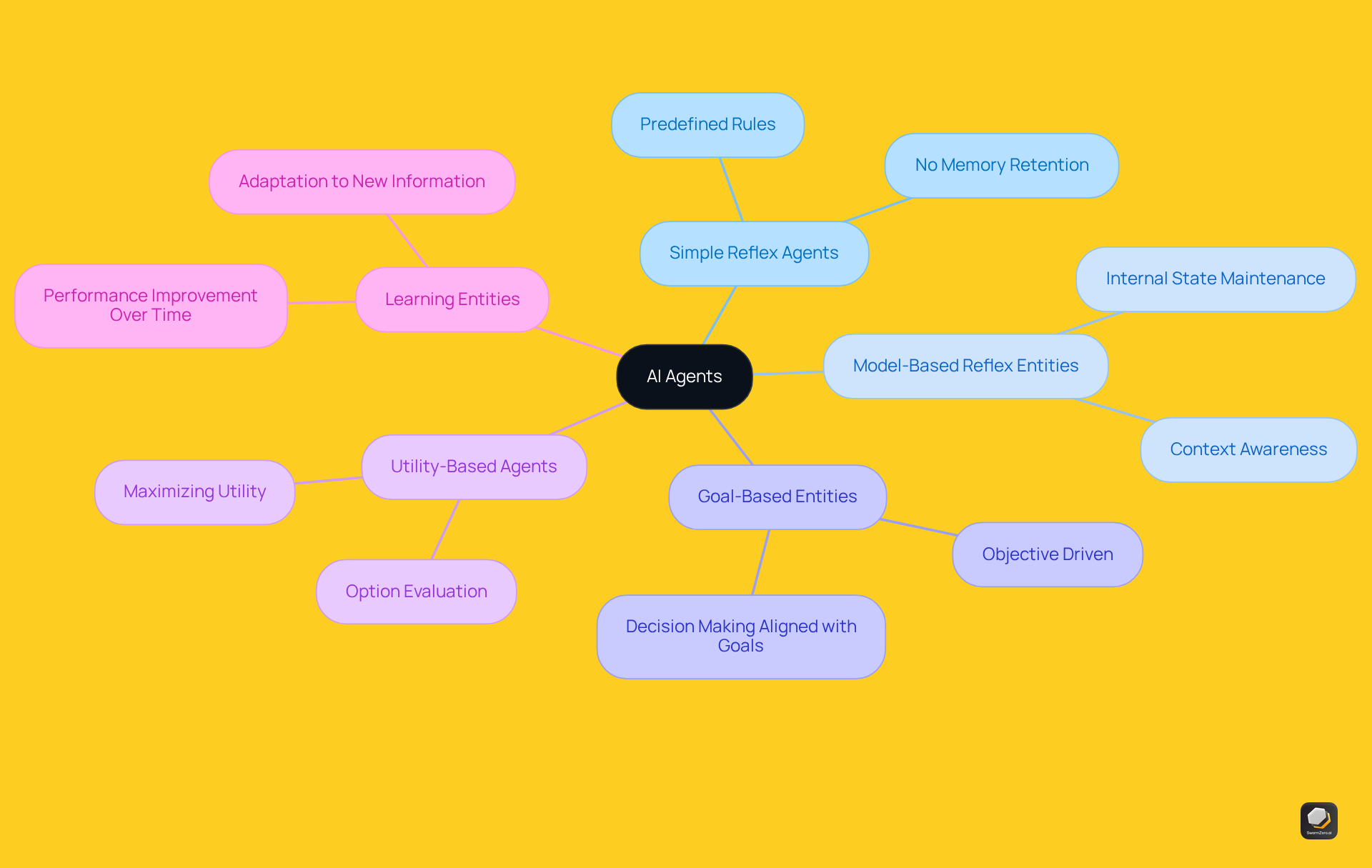
Define Your AI Agent's Purpose and Requirements
To effectively define your AI agent's purpose, follow these essential steps:
-
Identify the Problem: Determine the specific task or challenge your AI system will address. This could involve automating customer support, generating personalised sales proposals, or streamlining order processing.
-
Set Clear Objectives: Establish what success looks like for your AI system. Metrics such as response time, accuracy, and user satisfaction are critical for measuring effectiveness. Aligning objectives with business goals is crucial for maximising impact, as noted by industry leaders.
-
Determine Functional Requirements: Outline the necessary features your AI system must possess to achieve its objectives. For instance, a customer service representative should manage FAQs, process orders, and escalate issues when necessary. If you're looking to leverage AI for financial automation, consider how the AAVE Agent can be customised to meet specific financial tasks.
-
Consider User Interaction: Define the interaction methods users will have with the system. Options may include a chat interface, voice commands, or integration with existing tools like Salesforce or Hubspot.
By clearly defining these aspects, you will create a focused roadmap for how to make an AI agent from scratch. This ensures it effectively addresses business challenges and enhances operational efficiency.
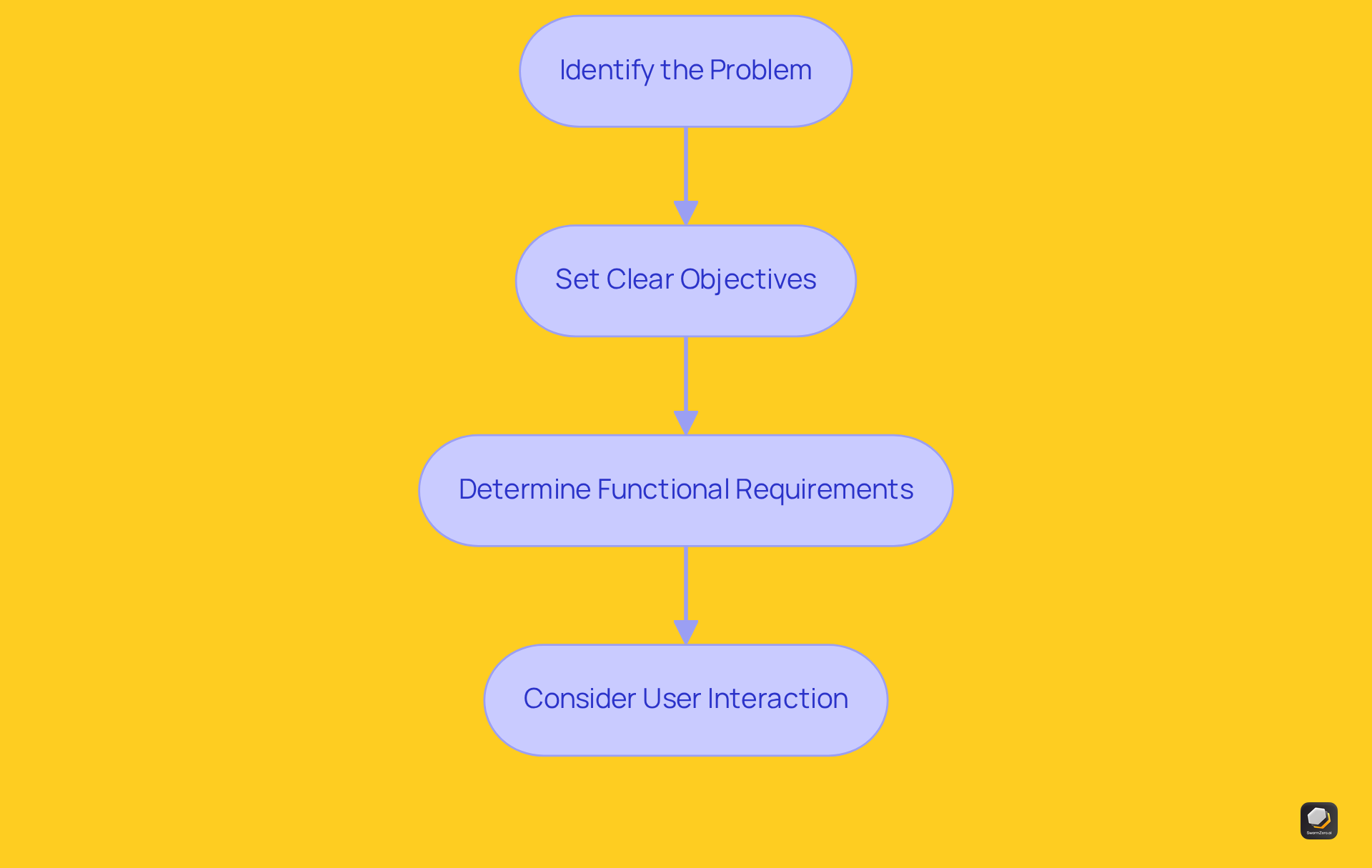
Choose the Right Tools and Frameworks for Development
When selecting tools and frameworks for your AI agent, it is essential to consider the following:
- Programming Language: Python stands out as the predominant choice for AI development, thanks to its extensive libraries and robust community support. Depending on your specific project needs, languages such as JavaScript or Java may also prove suitable.
- Frameworks: The landscape of popular frameworks includes:
- TensorFlow: Excellent for constructing machine learning models.
- PyTorch: The preferred option for research and prototyping.
- LangChain: Particularly useful for applications utilising language models.
- Rasa: Ideal for developing conversational interfaces.
- APIs and Libraries: Leverage APIs like OpenAI's GPT for natural language processing, alongside specialised libraries tailored for distinct functionalities.
- Development Environment: Establish a robust development environment using tools such as Jupyter Notebook for experimentation or Docker for effective containerization.
The strategic selection of these tools will significantly influence both your development efficiency and the overall effectiveness of your AI system.
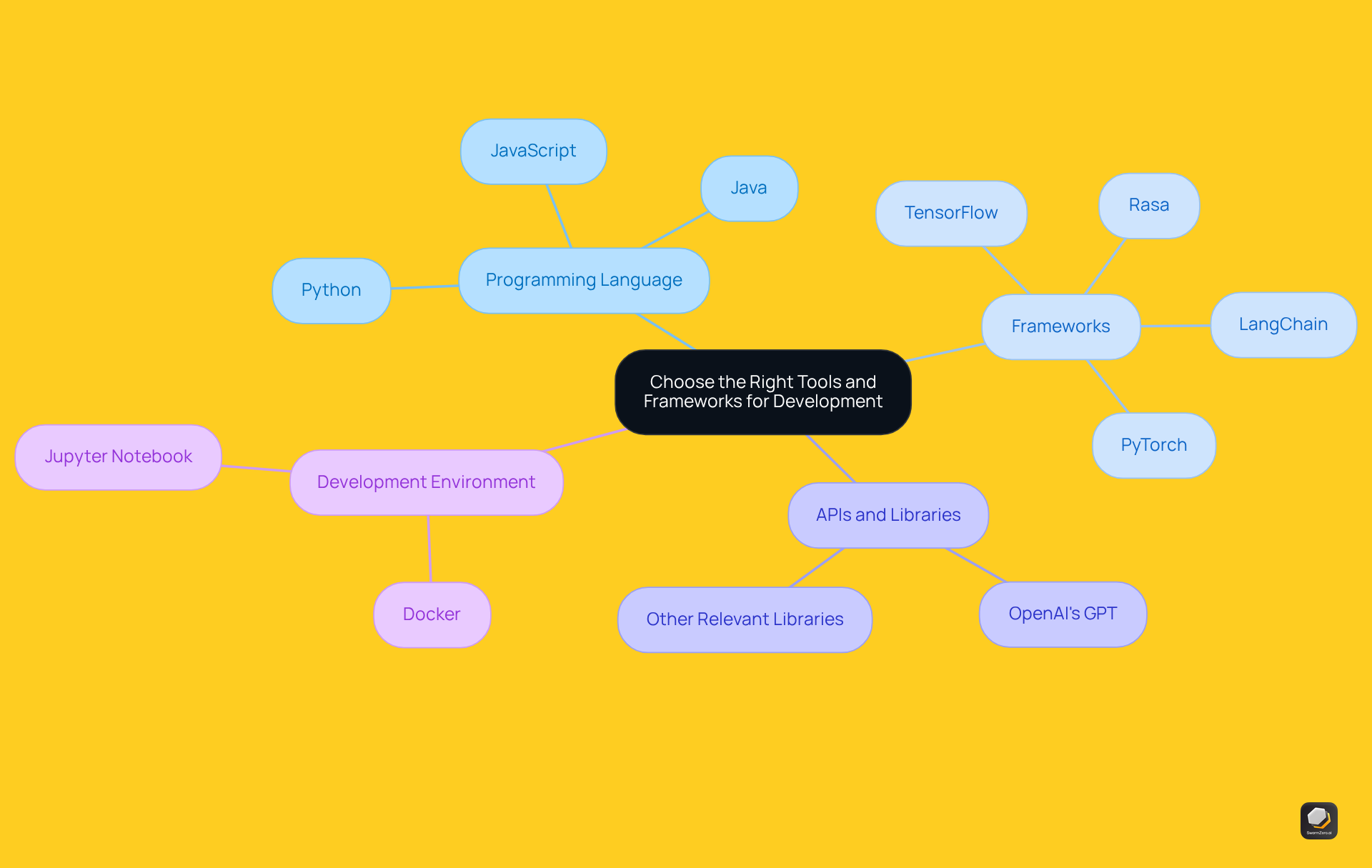
Design and Build Your AI Agent: Step-by-Step Process
To design and build your AI agent, follow these essential steps:
-
Create a Project Plan: Outline the timeline, resources, and milestones for your project. Statistics indicate that 62% of practitioners recognise security as a primary challenge in AI development, underscoring the necessity of thorough planning.
-
Set Up Your Development Environment: Install the necessary software and libraries based on your selected tools and frameworks. Ensure your environment is equipped to manage the complexities of AI integration.
-
Develop the Entity Logic: Write the code that defines how your entity will operate. This includes:
- Input Handling: Determine how the agent will receive and process user inputs.
- Decision-Making Logic: Specify how the entity will make decisions based on inputs and its objectives. Research reveals that 83% of sales teams using machine intelligence reported revenue growth, highlighting the critical nature of effective decision-making.
- Output Generation: Establish how the representative will respond to users.
-
Integrate APIs and Data Sources: Connect your representative to any external services or databases it requires to operate efficiently. Integrating tools can automate entire workflows, significantly enhancing efficiency.
-
Implement Interface: If relevant, create the layout through which individuals will engage with the assistant. A well-designed interface can greatly improve user engagement and satisfaction.
By following these steps on how to make an AI agent from scratch, you will create a functional AI entity tailored to your defined purpose, effectively addressing common challenges and leveraging best practices from successful AI developers.
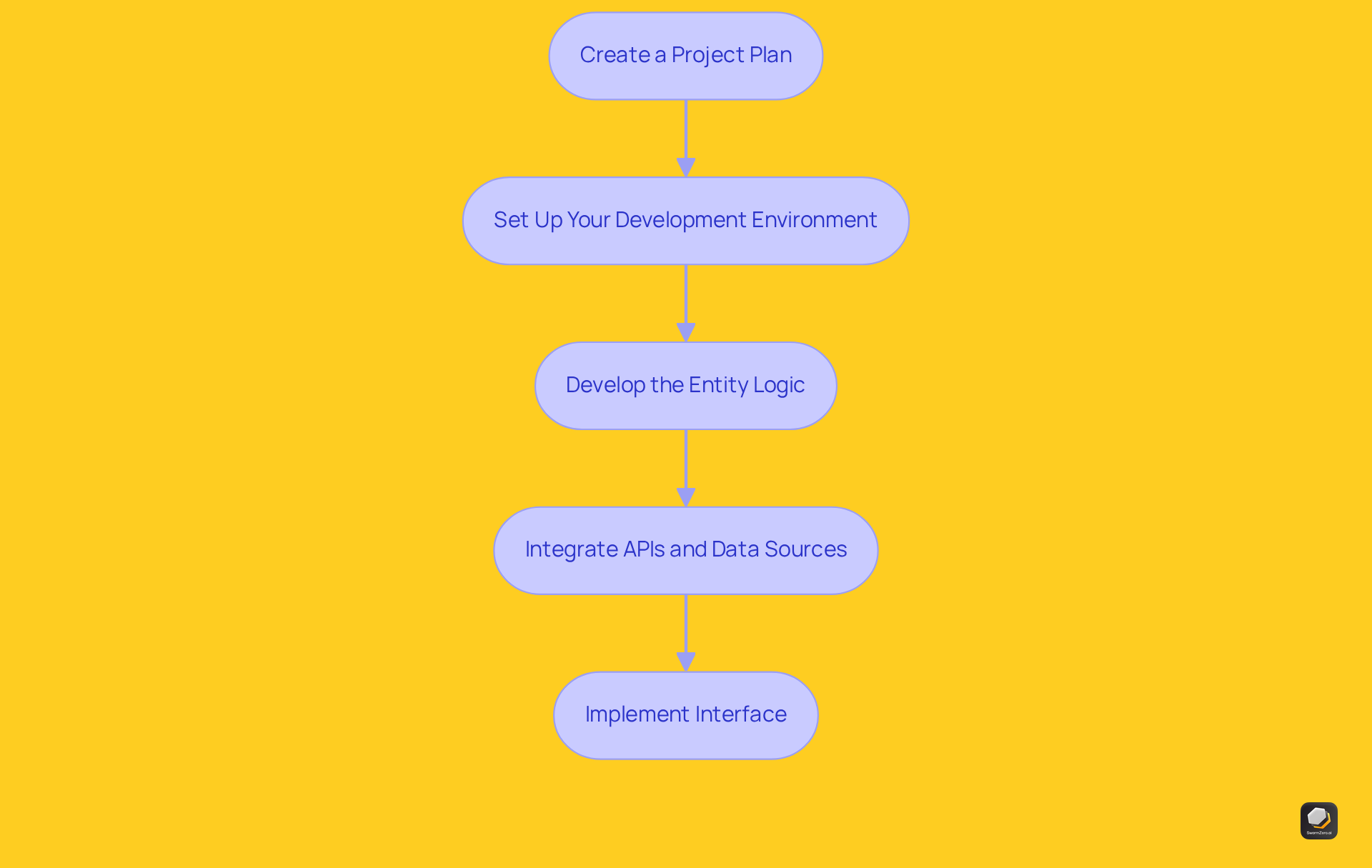
Test and Optimize Your AI Agent for Performance
To effectively test and optimise your AI agent utilising SwarmZero's capabilities, follow these essential guidelines:
- Develop Test Cases: Create scenarios that replicate real-world interactions with your system. This approach not only helps uncover potential issues but also highlights areas for enhancement.
- Conduct Participant Testing: Involve real individuals in the testing process to gather valuable feedback on the agent's performance and usability. This step is crucial for understanding client experiences and identifying pain points. Testimonials from SwarmZero clients emphasise the platform's simplicity and significant improvements in workflow efficiency, underscoring the importance of participant involvement in the testing process.
- Measure Effectiveness Metrics: Monitor key indicators (KPIs) such as response time, accuracy, and user satisfaction. Industry insights reveal that 80% of customer experience leaders consider quantifiable business impact the most critical factor when evaluating AI performance. These metrics provide a quantitative basis for assessing the effectiveness of the representative.
- Iterate Based on Feedback: Utilise insights gained from user testing to refine the system's logic, enhance responses, and improve overall user interactions. Continuous iteration is vital for learning how to make an AI agent from scratch to maintain relevance and effectiveness.
- Optimise Algorithms: Fine-tune the algorithms employed by your system to enhance decision-making capabilities and operational efficiency. SwarmZero offers sophisticated features such as linking various machine learning models and incorporating APIs, which can significantly bolster your system's effectiveness.
Routine assessments and enhancements are essential to ensure your AI system remains efficient and adapts to evolving demands. Usability specialists emphasise that focusing on user feedback is crucial for enhancing AI system performance, ultimately leading to greater user satisfaction and operational success.
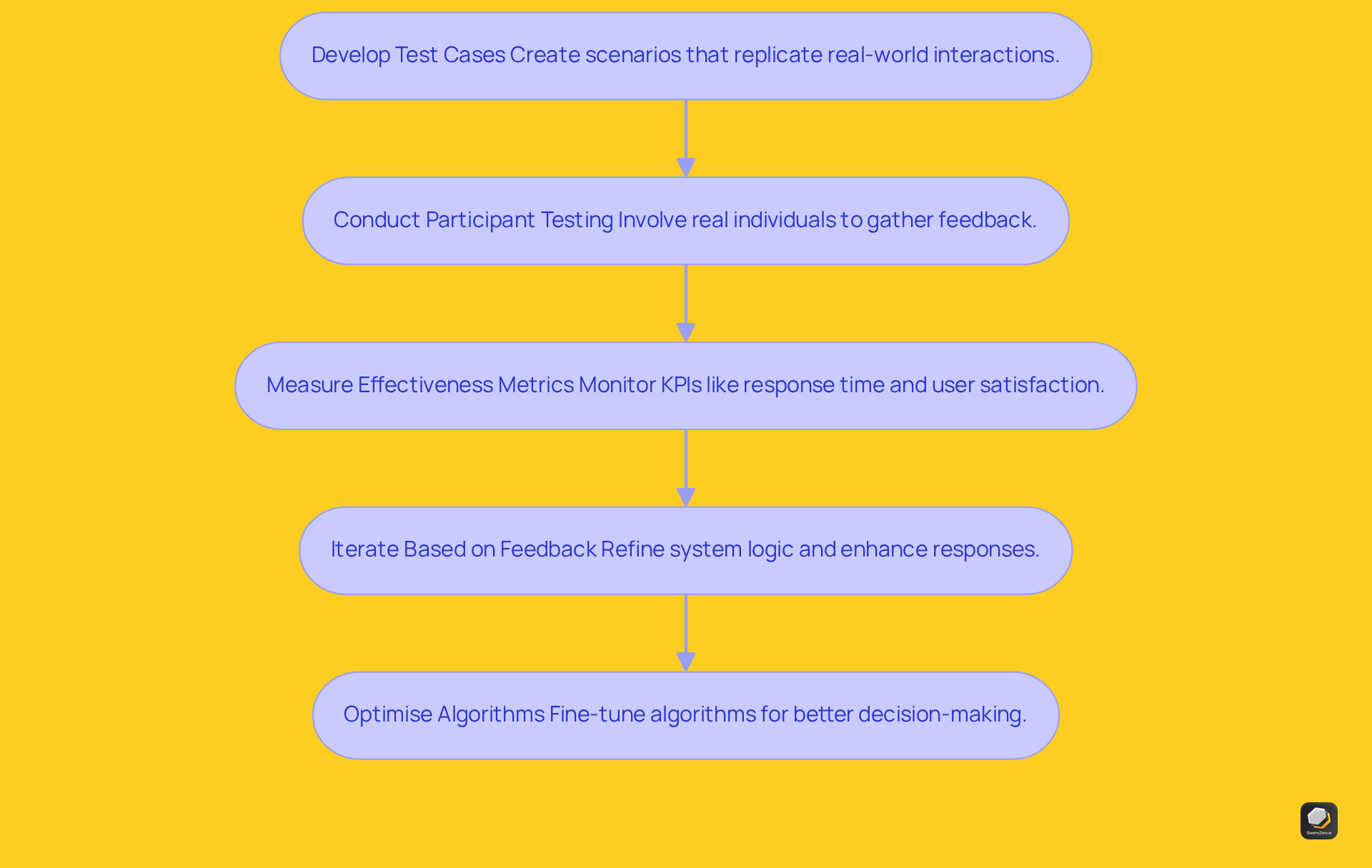
Deploy Your AI Agent: Best Practices and Considerations
When deploying your AI agent, consider the following best practises:
-
Choose the Right Hosting Environment: Decide whether to host your application on-premises or in the cloud. Cloud solutions provide scalability and flexibility, while on-premises hosting enhances security for sensitive data. Notably, companies are increasingly adopting cloud environments, with 80% of organisations planning to implement AI-powered chatbots by 2025, indicating a significant trend towards cloud-based solutions for AI deployment.
-
Monitor Effectiveness: Implement robust monitoring tools to track your agent's effectiveness in real-time. Statistics reveal that 52% of organisations are interested in generative AI for automation, underscoring the necessity of effective monitoring to ensure reliability and efficiency. Regular audits and performance evaluations are essential for identifying issues early, allowing for timely interventions.
-
Ensure Security and Compliance: Safeguard personal data by implementing robust security measures, including encryption and access controls. Compliance with regulations such as GDPR is crucial, as 60% of companies express concerns about privileged data access. Establishing clear data governance policies can significantly mitigate risks associated with AI deployment.
-
Offer Assistance: Establish an extensive support system to assist individuals with any challenges they encounter while engaging with the system. This can include FAQs, live chat support, and user guides. A well-supported AI system enhances client satisfaction and trust, as 72% of customers desire transparency regarding their interactions with AI. As noted by Zendesk, 80% of consumers feel more valued when autonomous assistants deliver hyper-personalised interactions.
-
Strategy for Ongoing Enhancement: Create a feedback loop to collect insights from individuals and implement continuous improvements to the system's functionality. Continuous evaluation is essential, with 39% of organisations committed to evolving their support systems using AI. Implementing frameworks like Human-in-the-loop (HITL) ensures that human oversight is integrated into the improvement process, enhancing reliability and accountability. Furthermore, 87% of executives believe generative AI will augment jobs rather than replace them, highlighting the importance of maintaining human involvement in AI processes.
By adhering to these best practises, you can learn how to make an AI agent from scratch, ensuring a successful deployment that maximises its effectiveness and user satisfaction.
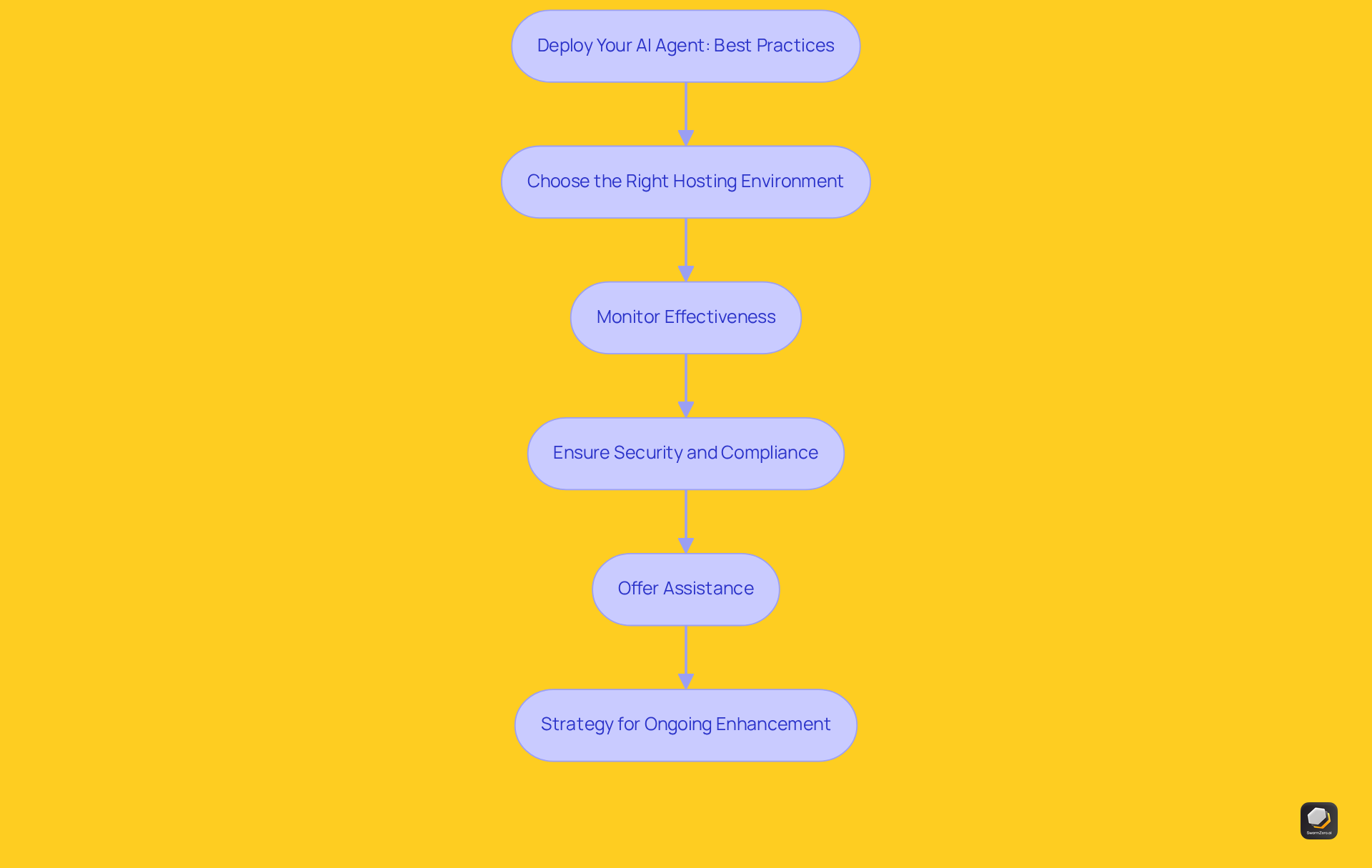
Conclusion
Creating an AI agent from scratch is an intricate yet rewarding endeavour that can significantly enhance productivity and efficiency across diverse applications. By comprehensively understanding the various types of AI agents and their functionalities, developers can tailor their projects to meet specific needs and objectives, ensuring that the AI systems they create are both effective and aligned with business goals.
Key steps are outlined throughout the article to guide the development of an AI agent, including:
- Defining its purpose
- Selecting appropriate tools and frameworks
- Designing the entity logic
- Implementing rigorous testing and optimization processes
Each phase is crucial in ensuring that the AI agent operates smoothly and meets user expectations. Furthermore, best practises for deployment underscore the importance of monitoring, security, and ongoing enhancements, which are vital for maintaining system reliability and user satisfaction.
In conclusion, the journey of building an AI agent from scratch transcends mere technical execution; it requires strategic planning and continuous improvement. As businesses increasingly adopt AI technologies, understanding how to create and deploy effective AI agents becomes essential. Embracing this knowledge not only empowers developers to innovate but also positions organisations to harness AI's full potential, driving future success and operational excellence.
Frequently Asked Questions
What are AI agents and what is their purpose?
AI agents are advanced software applications designed to autonomously execute tasks for users, enhancing operational effectiveness across various sectors.
What are the different types of AI agents?
The types of AI agents include: - Simple Reflex Agents: Respond to specific stimuli based on predefined rules without retaining memory. - Model-Based Reflex Entities: Maintain an internal state to manage a broader range of situations. - Goal-Based Entities: Make decisions aligned with specific objectives to achieve desired outcomes. - Utility-Based Agents: Evaluate options and select actions that maximise their utility based on defined preferences. - Learning Entities: Improve performance over time by learning from experiences and adapting to new information.
How are AI agents expected to impact businesses by 2025?
A significant percentage of businesses are expected to adopt AI tools by 2025, highlighting their increasing importance in streamlining operations.
Can you provide an example of where AI agents are used?
Simple reflex systems are commonly used in customer service chatbots, which provide prompt responses to inquiries based on predefined scripts.
What is the significance of understanding AI agent categories?
Understanding the categories of AI agents is crucial for identifying how to create an AI agent from scratch for specific projects.
What is the SwarmZero framework?
The SwarmZero framework is a comprehensive AI marketplace designed for those looking to learn how to create an AI agent from scratch while developing, monetising, and automating business solutions.
What steps should be followed to define an AI agent's purpose?
The essential steps to define an AI agent's purpose include: - Identify the Problem: Determine the specific task or challenge the AI system will address. - Set Clear Objectives: Establish metrics for success, such as response time and user satisfaction. - Determine Functional Requirements: Outline necessary features for the AI system to achieve its objectives. - Consider User Interaction: Define how users will interact with the system, such as through chat interfaces or voice commands.
Why is it important to align AI objectives with business goals?
Aligning AI objectives with business goals is crucial for maximising impact and ensuring the AI system effectively addresses business challenges.
List of Sources
- Understand AI Agents: Definition and Types
- 18 Inspiring Agentic AI Quotes From Industry Leaders (https://atera.com/blog/agentic-ai-quotes)
- Copilot and AI Agents | Microsoft Copilot (https://microsoft.com/en-us/microsoft-copilot/copilot-101/copilot-ai-agents)
- What Are AI Agents? | IBM (https://ibm.com/think/topics/ai-agents)
- AI agents — what they are, and how they'll change the way we work - Source (https://news.microsoft.com/source/features/ai/ai-agents-what-they-are-and-how-theyll-change-the-way-we-work)
- 20+ insightful quotes on AI Agents and AGI from AI experts and leaders - Applied AI Tools (https://appliedai.tools/resources/quotes-on-ai-agents-and-agi-from-ai-experts-and-leaders)
- Define Your AI Agent's Purpose and Requirements
- Microsoft Build 2025: The age of AI agents and building the open agentic web - The Official Microsoft Blog (https://blogs.microsoft.com/blog/2025/05/19/microsoft-build-2025-the-age-of-ai-agents-and-building-the-open-agentic-web)
- How To Build The Ultimate AI News Agent In 2025 (https://forbes.com/sites/aytekintank/2025/06/17/how-to-build-the-ultimate-ai-news-agent-in-2025)
- 42 Customer Service Statistics To Move Your Business Forward (https://salesforce.com/blog/customer-service-stats)
- The Definitive Guide to AI Agents in 2025: Technical Implementation, Strategic Decisions, and Market Reality (https://natesnewsletter.substack.com/p/the-definitive-guide-to-ai-agents)
- Will 2025 Be the Year of the AI Agents? (https://internationalbanker.com/technology/will-2025-be-the-year-of-the-ai-agents)
- Choose the Right Tools and Frameworks for Development
- Top AI Programming Languages You Should Know in 2025 (https://radixweb.com/blog/ai-programming-languages)
- 15 Quotes on the Future of AI (https://time.com/partner-article/7279245/15-quotes-on-the-future-of-ai)
- The 10 Hottest Agentic AI Tools And Agents Of 2025 (So Far) (https://crn.com/news/ai/2025/10-hottest-agentic-ai-tools-and-agents-of-2025-so-far)
- Top 10 Expert Quotes That Redefine the Future of AI Technology (https://nisum.com/nisum-knows/top-10-thought-provoking-quotes-from-experts-that-redefine-the-future-of-ai-technology)
- Design and Build Your AI Agent: Step-by-Step Process
- How To Build The Ultimate AI News Agent In 2025 (https://forbes.com/sites/aytekintank/2025/06/17/how-to-build-the-ultimate-ai-news-agent-in-2025)
- 30+ Powerful AI Agents Statistics In 2025: Adoption & Insights (https://warmly.ai/p/blog/ai-agents-statistics)
- AI Agent Statistics for 2025: Adoption, ROI, Performance & More (https://plivo.com/blog/ai-agents-top-statistics)
- 150+ AI Agent Statistics [July 2025] (https://masterofcode.com/blog/ai-agent-statistics)
- Microsoft Just Revealed 5 New AI Agents to Help You Work Smarter (https://inc.com/ben-sherry/microsoft-just-revealed-5-new-ai-agents-to-help-you-work-smarter/91020857)
- Test and Optimize Your AI Agent for Performance
- 18 Inspiring Agentic AI Quotes From Industry Leaders (https://atera.com/blog/agentic-ai-quotes)
- +20 Quotes about AI from Industry Experts (https://linkedin.com/pulse/20-quotes-ai-from-industry-experts-jordi-arias-6o19f)
- Measuring AI Agent Performance: What Metrics Really Matter? (https://loris.ai/blog/measuring-ai-agent-performance-what-metrics-actually-matter)
- 80+ AI Agent Usage Stats for 2025 | Zebracat (https://zebracat.ai/post/ai-agent-usage-statistics)
- Deploy Your AI Agent: Best Practices and Considerations
- PwC’s AI Agent Survey (https://pwc.com/us/en/tech-effect/ai-analytics/ai-agent-survey.html)
- AI Agent Best Practices and Ethical Considerations | Writesonic (https://writesonic.com/blog/ai-agents-best-practices)
- AI Agent Statistics for 2025: Adoption, ROI, Performance & More (https://plivo.com/blog/ai-agents-top-statistics)
- 150+ AI Agent Statistics [July 2025] (https://masterofcode.com/blog/ai-agent-statistics)
- 200+ AI Agent statistics for 2025 (https://pragmaticcoders.com/resources/ai-agent-statistics)




